

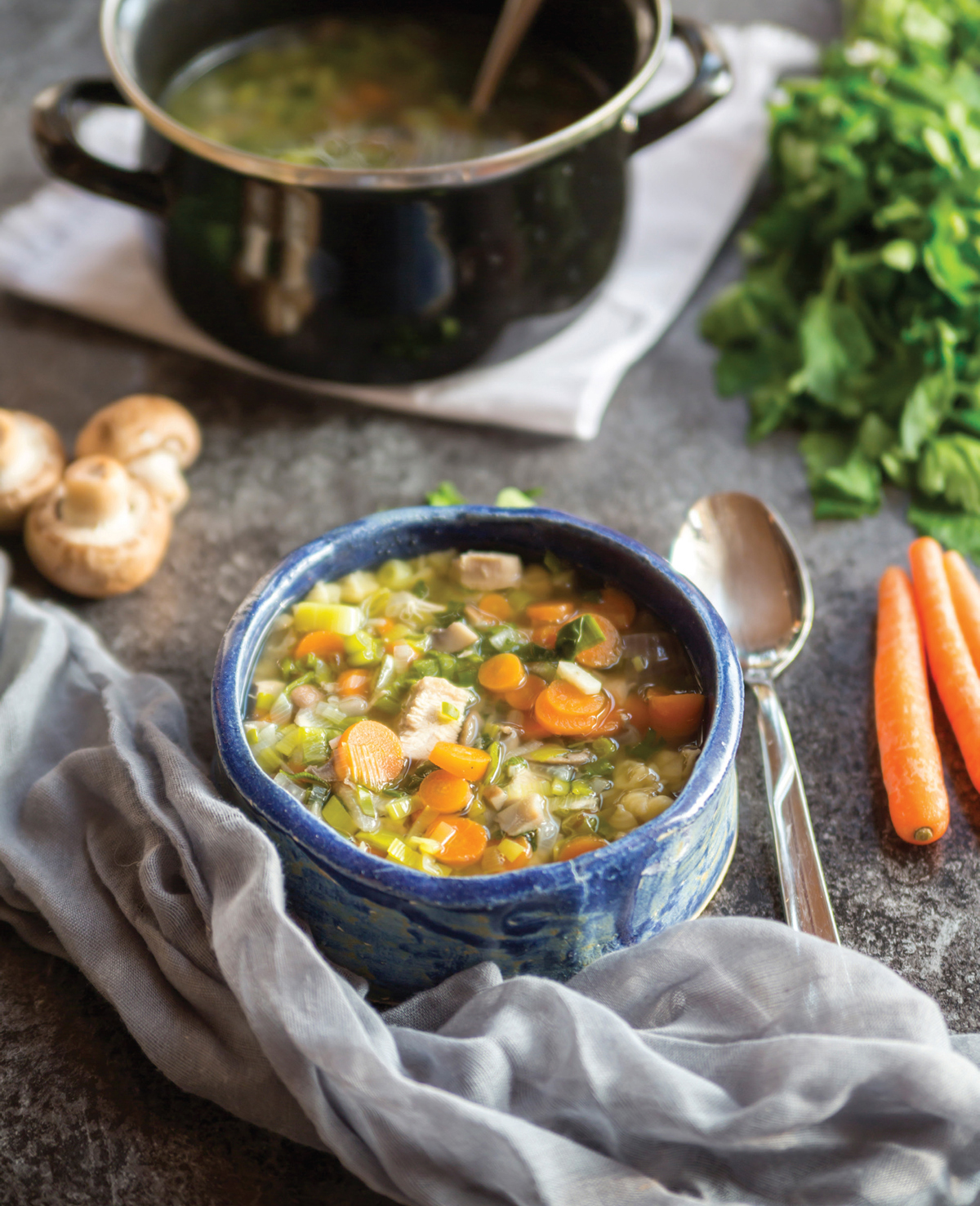
 Copyright 2019 by Abigail R. Gehring Photos by Clare Barboza and Bonnie Matthews. Photos on courtesy of Getty Images. All rights reserved. No part of this book may be reproduced in any manner without the express written consent of the publisher, except in the case of brief excerpts in critical reviews or articles. All inquiries should be addressed to Good Books, 307 West 36th Street, 11th Floor, New York, NY 10018.
Copyright 2019 by Abigail R. Gehring Photos by Clare Barboza and Bonnie Matthews. Photos on courtesy of Getty Images. All rights reserved. No part of this book may be reproduced in any manner without the express written consent of the publisher, except in the case of brief excerpts in critical reviews or articles. All inquiries should be addressed to Good Books, 307 West 36th Street, 11th Floor, New York, NY 10018.
Good Books books may be purchased in bulk at special discounts for sales promotion, corporate gifts, fund-raising, or educational purposes. Special editions can also be created to specifications. For details, contact the Special Sales Department, Good Books, 307 West 36th Street, 11th Floor, New York, NY 10018 or . Good Books is an imprint of Skyhorse Publishing, Inc., a Delaware corporation. Visit our website at www.goodbooks.com. 10 9 8 7 6 5 4 3 2 1 Library of Congress Cataloging-in-Publication Data is available on file.
Cover design by Brian Peterson Cover photo courtesy of Getty Images Print ISBN: 978-1-68099-482-7 Ebook ISBN: 978-1-68099-483-4 Printed in China Contents 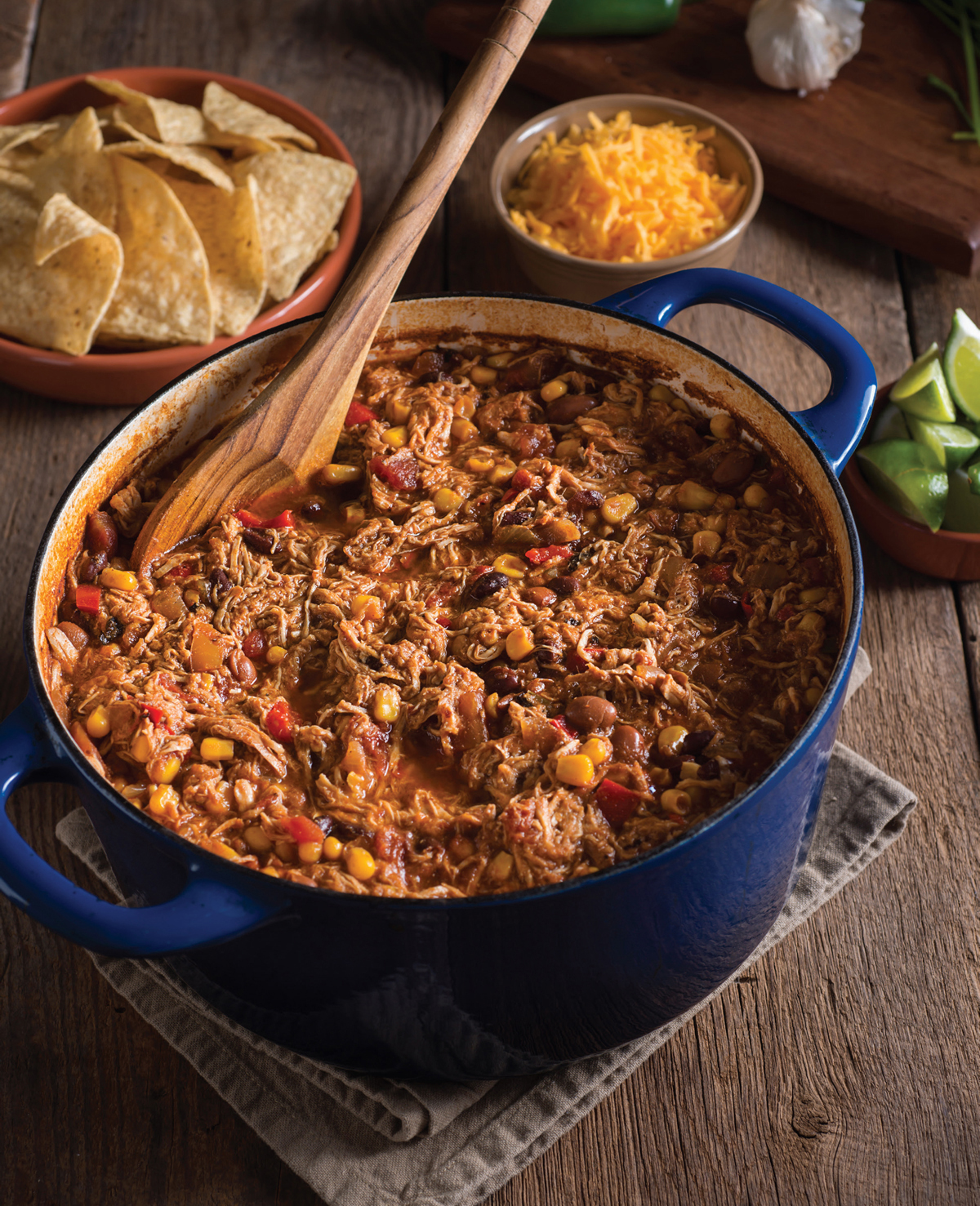 Introduction Theres nothing quite like a nourishing bowl of chicken soup when youre under the weather, a pot of chili for the big game, or a good seafood chowder on a summer evening at the beach house. In fact, Id argue that theres a soup, stew, chili, or chowder for every occasion. Soups are so versatiletheyre the little black dress of the culinary world. Dress them up for a fancy event, dress them down for lunch at the office. And perhaps best of all, many are so easy to make! What makes these soups "Super Easy?" The recipes in this bookcollected from some of the smartest home cooks across the countryall require 30 minutes or less of preparation time. For days when even half an hour is too much, the recipes marked with a Quick Prep icon in the top corner of the page all require 15 minutes or less of prep work.
Introduction Theres nothing quite like a nourishing bowl of chicken soup when youre under the weather, a pot of chili for the big game, or a good seafood chowder on a summer evening at the beach house. In fact, Id argue that theres a soup, stew, chili, or chowder for every occasion. Soups are so versatiletheyre the little black dress of the culinary world. Dress them up for a fancy event, dress them down for lunch at the office. And perhaps best of all, many are so easy to make! What makes these soups "Super Easy?" The recipes in this bookcollected from some of the smartest home cooks across the countryall require 30 minutes or less of preparation time. For days when even half an hour is too much, the recipes marked with a Quick Prep icon in the top corner of the page all require 15 minutes or less of prep work.
Once the ingredients are in the pot, most recipes allow you to leave the soup simmering while you go take care of other matters (or just relax!). Some may ask for a quick stir now and again or a final step of adding an ingredient or blending everything together for a smooth, creamy soup. If youll need to leave the house while the soup is simmering, opt for one of the recipes with the slow cooker icon on topcooking in a slow cooker (or with the slow cooker setting on your multi-cooker) takes longer, but youre free to go to sleep or leave the house without worrying about an open flame. Choosing a Pot Theres no rule saying you have to cook your soup in any particular kind of pot, but a pot with some substance will help prevent burning on the bottom when cooking thicker soups and stews. Technically, a stock pot has a flat base, tall sides, and a lid, and is often made of thin aluminum, stainless steel, or heat-resistant glass. Stock pots are fine for making stocks, broths, or other thin soups.
But if youre investing in one new pot, Id go with a soup pot or Dutch oven, both of which are made of heavier materialsoften cast iron with a colorful enamel coating. Not only are they more versatile for soup-making, but theyll come in handy for a variety of other cooking purposessoup pots are perfect for making pasta, for example, and Dutch ovens bake a great loaf of sourdough. Slow cookers are also a great help to busy home cooks since, as mentioned earlier, you can leave them to do their job without worrying about an open flame in your home. They do require longer cook times, so when you see the slow cooker icon above a recipe, know youll need to plan ahead several hours. If you dont have a slow cooker but intend to get one, consider opting for a multi-cooker (such as an Instant Pot) to get more bang for your buck. Stocking Your Pantry and Freezer There are a handful of ingredients youll see over and over again in these recipes, so you may as well stock up next time you see a good sale. Pantry: Chicken stock and/or broth Beef stock and/or broth Vegetable stock and/or broth Black beans Kidney beans Pinto beans Canned corn Canned diced tomatoes Freezer: Boneless, skinless chicken breasts Ground beef Frozen veggies (corn, peas, carrots, mixed) Spice Shelf: Bay leaves Chili powder Cumin Garlic cloves Oregano Salt and pepper Thyme Stocks vs. Pantry: Chicken stock and/or broth Beef stock and/or broth Vegetable stock and/or broth Black beans Kidney beans Pinto beans Canned corn Canned diced tomatoes Freezer: Boneless, skinless chicken breasts Ground beef Frozen veggies (corn, peas, carrots, mixed) Spice Shelf: Bay leaves Chili powder Cumin Garlic cloves Oregano Salt and pepper Thyme Stocks vs.
Broths Stock and broth are interchangeable in most recipes, so if you see one called for and only have the other, feel free to use what you have. Stock is usually made from simmering the meat bones for long periods, which results in more gelatin in the liquid. This adds a richer texture and more nutrients than broth has, which is made with more meat than bones. To make your own meat stocks or vegetable broth, see . 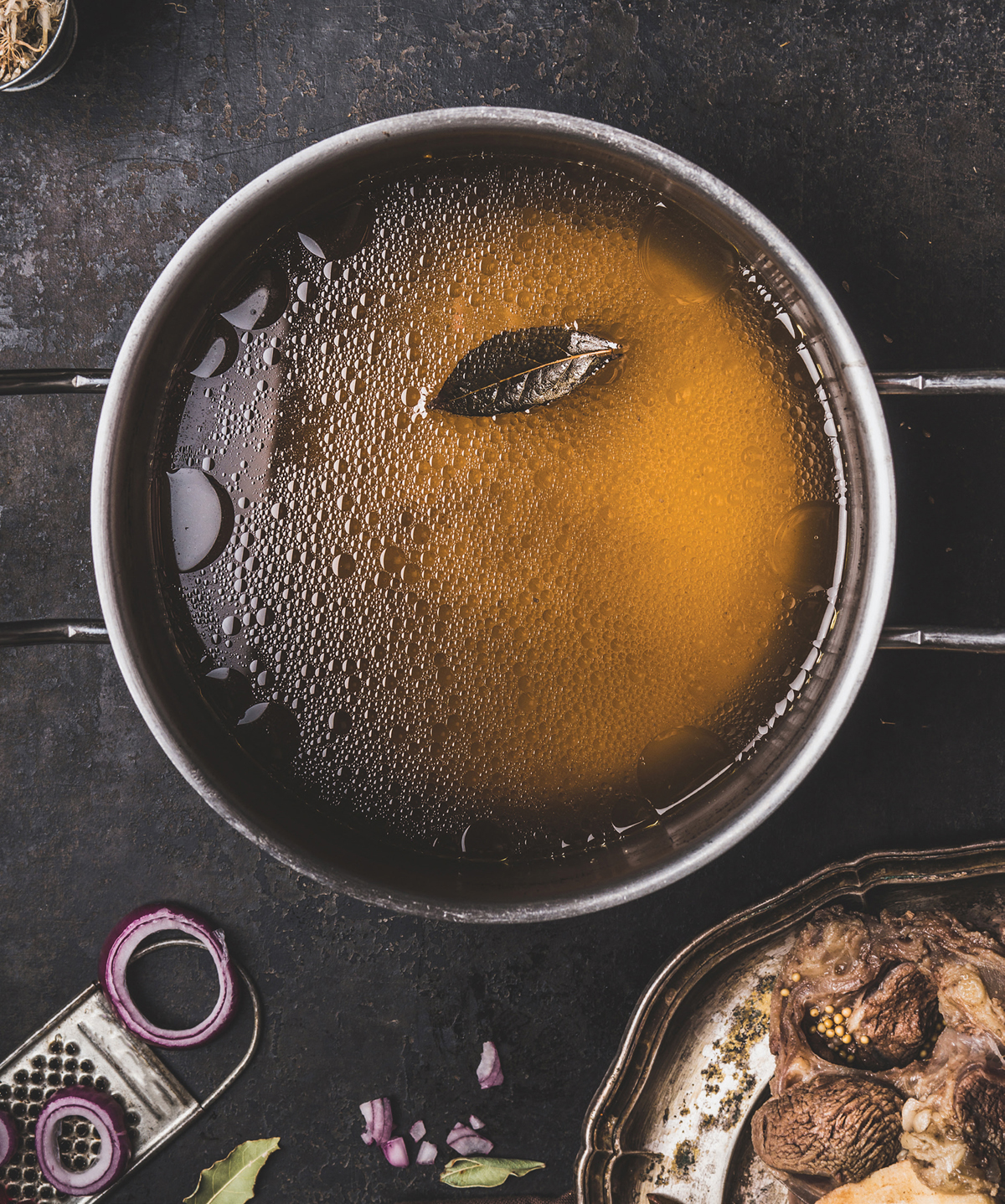
 Freezing Your Soups, Stews, Chilis, and Chowders One of the best parts of making a big pot of soup is being able to freeze some for another day, or to gift to a loved one when theyre ill, just had a baby, or could just use a quick meal! Allow your soup to cool and then ladle into plastic containers with tight lids, glass canning jars, or re-sealable plastic bags. Whatever you use, be sure to leave extra space, as liquids expand as they freeze.
Freezing Your Soups, Stews, Chilis, and Chowders One of the best parts of making a big pot of soup is being able to freeze some for another day, or to gift to a loved one when theyre ill, just had a baby, or could just use a quick meal! Allow your soup to cool and then ladle into plastic containers with tight lids, glass canning jars, or re-sealable plastic bags. Whatever you use, be sure to leave extra space, as liquids expand as they freeze.
This is especially important if youre using glass jarsyou dont want glass shattering all over your freezer! Label your container with the kind of soup and the date. Most soups will stay good for at least four months in the freezer, often much longer. To thaw, place the container in a bowl of warm water until the soup becomes more like a slushy (big chunks are fine). Then pour into a pot and simmer until hot. 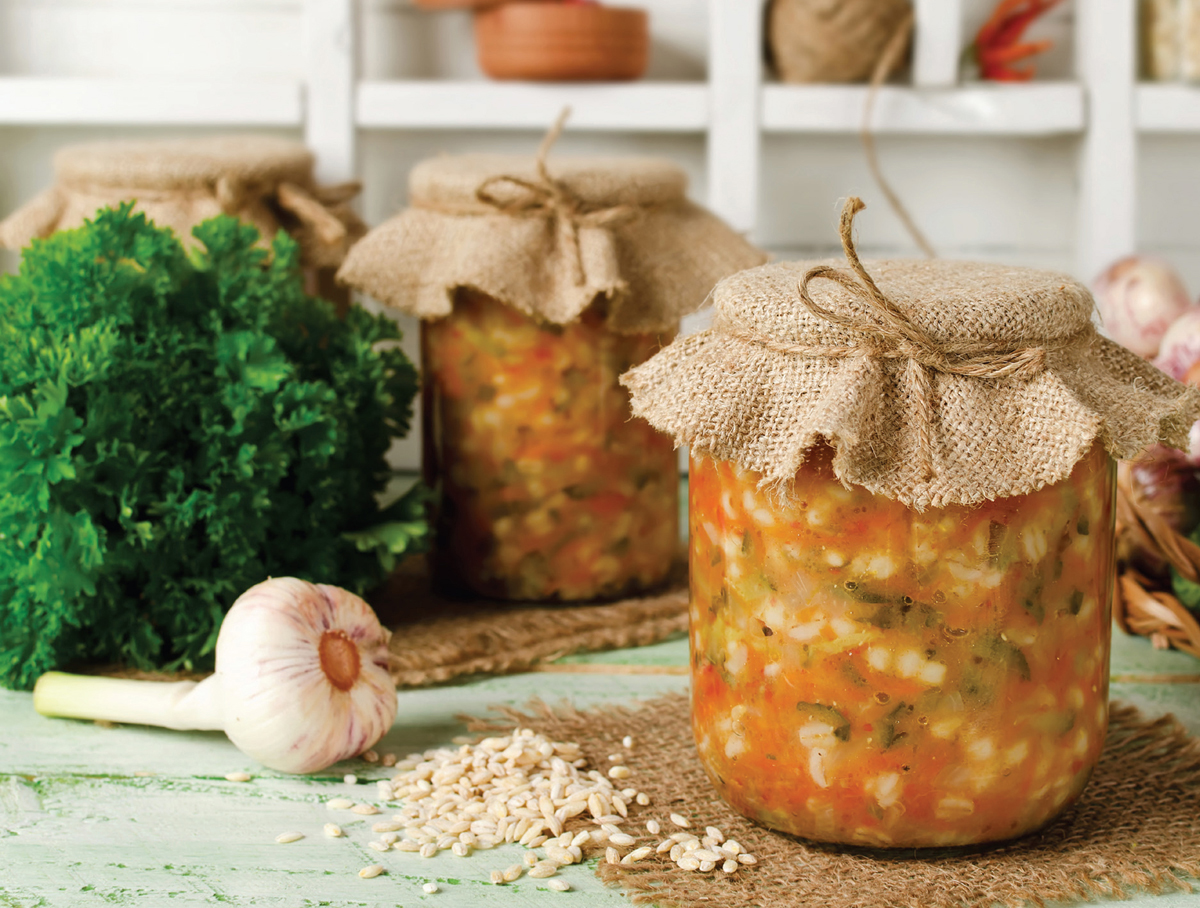 Pro Tips Keeping soups and stews at a simmer allows all the ingredients to cook through evenly. Be careful not to boil too vigorouslyyoull end up with tough meat and possibly a very messy stove.
Pro Tips Keeping soups and stews at a simmer allows all the ingredients to cook through evenly. Be careful not to boil too vigorouslyyoull end up with tough meat and possibly a very messy stove.
Taking the time to saut your onions and garlic in a bit of butter or olive oil prior to adding your liquids will create a much richer layer of flavor in your soup. Soups are great for utilizing food scraps (toss that Parmesan cheese rind in your broth!) and less pretty vegetables (that gnarled carrot in the veggie drawer, those weirdly shaped potatoes). Veggie scraps (onion skins, celery tops) can also be used to make great stocks and broths. Chopping veggies does take time. Good quality, sharp knives will make the job faster and safer. Hold the knife between your thumb and pointer finger at the base of the blade and allow the other fingers to wrap around the top of the handle for the most control.
Next page
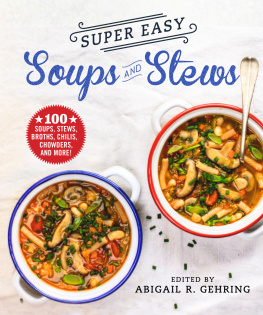
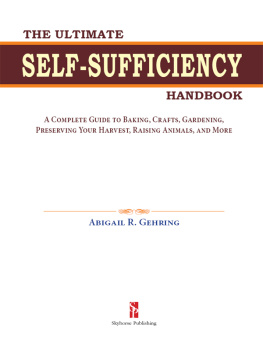
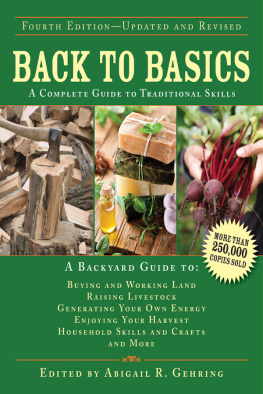
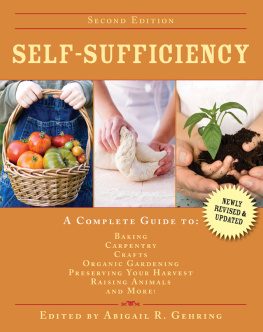

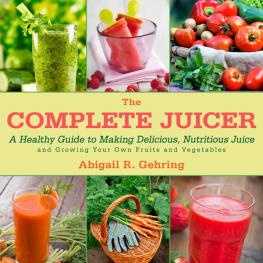

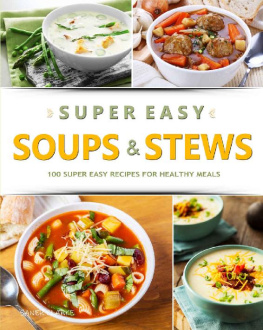

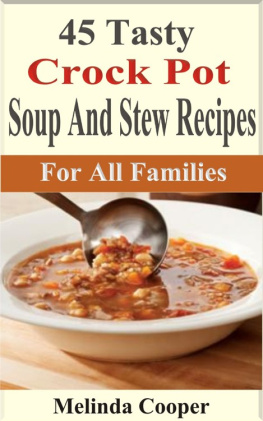


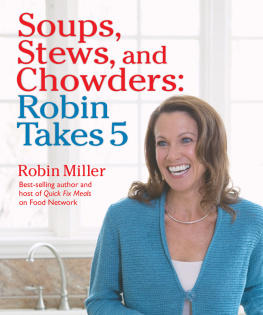
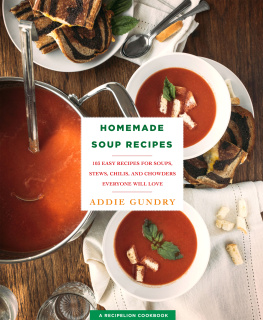
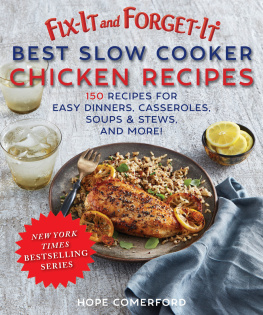
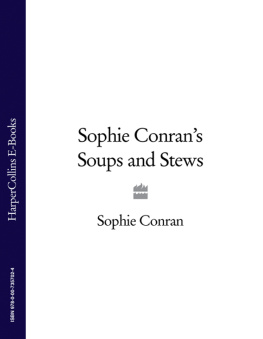
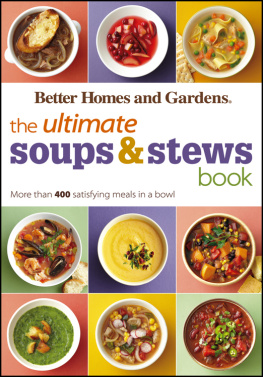



 Copyright 2019 by Abigail R. Gehring Photos by Clare Barboza and Bonnie Matthews. Photos on courtesy of Getty Images. All rights reserved. No part of this book may be reproduced in any manner without the express written consent of the publisher, except in the case of brief excerpts in critical reviews or articles. All inquiries should be addressed to Good Books, 307 West 36th Street, 11th Floor, New York, NY 10018.
Copyright 2019 by Abigail R. Gehring Photos by Clare Barboza and Bonnie Matthews. Photos on courtesy of Getty Images. All rights reserved. No part of this book may be reproduced in any manner without the express written consent of the publisher, except in the case of brief excerpts in critical reviews or articles. All inquiries should be addressed to Good Books, 307 West 36th Street, 11th Floor, New York, NY 10018. Introduction Theres nothing quite like a nourishing bowl of chicken soup when youre under the weather, a pot of chili for the big game, or a good seafood chowder on a summer evening at the beach house. In fact, Id argue that theres a soup, stew, chili, or chowder for every occasion. Soups are so versatiletheyre the little black dress of the culinary world. Dress them up for a fancy event, dress them down for lunch at the office. And perhaps best of all, many are so easy to make! What makes these soups "Super Easy?" The recipes in this bookcollected from some of the smartest home cooks across the countryall require 30 minutes or less of preparation time. For days when even half an hour is too much, the recipes marked with a Quick Prep icon in the top corner of the page all require 15 minutes or less of prep work.
Introduction Theres nothing quite like a nourishing bowl of chicken soup when youre under the weather, a pot of chili for the big game, or a good seafood chowder on a summer evening at the beach house. In fact, Id argue that theres a soup, stew, chili, or chowder for every occasion. Soups are so versatiletheyre the little black dress of the culinary world. Dress them up for a fancy event, dress them down for lunch at the office. And perhaps best of all, many are so easy to make! What makes these soups "Super Easy?" The recipes in this bookcollected from some of the smartest home cooks across the countryall require 30 minutes or less of preparation time. For days when even half an hour is too much, the recipes marked with a Quick Prep icon in the top corner of the page all require 15 minutes or less of prep work.
 Freezing Your Soups, Stews, Chilis, and Chowders One of the best parts of making a big pot of soup is being able to freeze some for another day, or to gift to a loved one when theyre ill, just had a baby, or could just use a quick meal! Allow your soup to cool and then ladle into plastic containers with tight lids, glass canning jars, or re-sealable plastic bags. Whatever you use, be sure to leave extra space, as liquids expand as they freeze.
Freezing Your Soups, Stews, Chilis, and Chowders One of the best parts of making a big pot of soup is being able to freeze some for another day, or to gift to a loved one when theyre ill, just had a baby, or could just use a quick meal! Allow your soup to cool and then ladle into plastic containers with tight lids, glass canning jars, or re-sealable plastic bags. Whatever you use, be sure to leave extra space, as liquids expand as they freeze. Pro Tips Keeping soups and stews at a simmer allows all the ingredients to cook through evenly. Be careful not to boil too vigorouslyyoull end up with tough meat and possibly a very messy stove.
Pro Tips Keeping soups and stews at a simmer allows all the ingredients to cook through evenly. Be careful not to boil too vigorouslyyoull end up with tough meat and possibly a very messy stove.